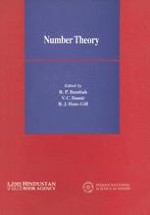2000 | OriginalPaper | Chapter
Siegel’s Main Theorem for Quadratic Forms
Author : S. Raghavan
Published in: Number Theory
Publisher: Hindustan Book Agency
Included in: Professional Book Archive
Activate our intelligent search to find suitable subject content or patents.
Select sections of text to find matching patents with Artificial Intelligence. powered by
Select sections of text to find additional relevant content using AI-assisted search. powered by
A classical question in the Theory of Numbers is one of expressing a positive integer as a sum of squares of integers. The qualitative aspects of this problem require at times no more than rudimentary congruence considerations e.g. a prime number leaving remainder 3 on division by 4 cannot be a sum of two squares of integers; however, in general, subtle arguments are called for. Fermat’s Principle of Descent needs to come into play for a proof of the (Euler-Fermat-) Lagrange theorem that every positive integer is a sum of four squares of integers. Skillful use of elliptic theta functions was made by Jacobi to obtain a quantitative refinement of that assertion, viz. according as n is an odd or even natural number, the number of ways of expressing n as a sum of four squares of integers is 8σ*(n) or 24σ*(n), where σ* (t) for any natural number t is the sum of all the odd natural numbers dividing t; Jacobi’s famous identity linking θ34 with other theta constants θ2, θ4 and their derivatives is an analytic encapsulation of all these formulae for varying n. An analytic formulation of similar nature arises also as a special case of the Siegel formula (extended suitably to cover the boundary case of quaternary quadratic forms as well) which connects theta series associated with quadratic forms to Eisenstein series: for complex z with positive imaginary part, <math display='block'> <mtable columnalign='left'> <mtr> <mtd> <msup> <mrow><mo>(</mo> <mrow> <mstyle displaystyle='true'> <munder> <mo>∑</mo> <mrow> <mi>n</mi><mo>∈</mo><mi>ℤ</mi> </mrow> </munder> <mrow> <mi>exp</mi><mrow><mo>(</mo> <mrow> <mi>π</mi><mtext> </mtext><mi>i</mi><mtext> </mtext><msup> <mi>n</mi> <mn>2</mn> </msup> <mtext> </mtext><mi>z</mi> </mrow> <mo>)</mo></mrow> </mrow> </mstyle> </mrow> <mo>)</mo></mrow> <mn>4</mn> </msup> <mo>=</mo><mn>1</mn><mo>+</mo><mstyle displaystyle='true'> <munder> <mo>∑</mo> <mrow> <mi>q</mi><mo>∈</mo><mi>ℤ</mi> </mrow> </munder> <mrow> <msup> <mrow> <mstyle displaystyle='true'> <munder> <mo>∑</mo> <mrow> <mi>p</mi><mo>∈</mo><mi>ℤ</mi> </mrow> </munder> <mrow> <mrow><mo>(</mo> <mrow> <mi>p</mi><mo>−</mo><mi>q</mi><mi>z</mi> </mrow> <mo>)</mo></mrow> </mrow> </mstyle> </mrow> <mrow> <mo>−</mo><mn>2</mn> </mrow> </msup> </mrow> </mstyle> </mtd> </mtr> <mtr> <mtd> <mrow><mo>(</mo> <mrow> <mi>p</mi><mo>,</mo><mi>q</mi> </mrow> <mo>)</mo></mrow><mo>=</mo><mn>1</mn><mo>,</mo><mi>p</mi><mo>+</mo><mi>q</mi><mo>≡</mo><mn>1</mn><mo stretchy='false'>(</mo><mi>mod</mi><mn>2</mn><mo stretchy='false'>)</mo> </mtd> </mtr> </mtable> </math>$$\begin{gathered} {\left( {\sum\limits_{n \in \mathbb{Z}} {\exp \left( {\pi \;i\;{n^2}\;z} \right)} } \right)^4} = 1 + \sum\limits_{q \in \mathbb{Z}} {{{\sum\limits_{p \in \mathbb{Z}} {\left( {p - qz} \right)} }^{ - 2}}} \hfill \\ \left( {p,q} \right) = 1,p + q \equiv 1(\bmod 2) \hfill \\ \end{gathered} $$ where the sum over p, q giving the Eisenstein series on the right hand side is only conditionally convergent and can be realized from an absolutely convergent Eisenstein series by analytic continuation via Hecke’s Grenzprozess (The inner sum over p is over all integers which are coprime to q and are of opposite parity to q).
